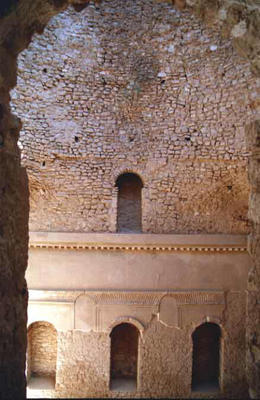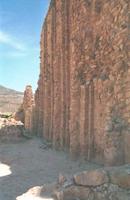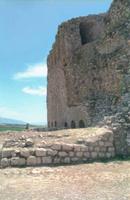In search for Chaar-Taagh in reliable sources, I use encyclopedia iranica as the first step. Here, in case of Chaar-Taagh, I treated iranica text in the same way I treated it in history of Bam for page. I try to transfer the whole text of iranica to an easy to read article. Paragraphs, emphasizes, titles or subtitles are mine. Thanks to computer and internet these days, I can continue working on them, reflecting your comments and adding pictures and maps. --Siamak D. Ahi
Chaar-Taagh
--------------
Meaning
Chaar-Taagh, literally "four arches", is an equilateral architectural unit consisting of four arches or short Barrel vaults between four corner piers, with a dome on squinches over the central square; this square and the lateral bays under the arches or barrel vaults together constitute a room of cruciform ground plan, Chaar-Taagh is the most prominent element in traditional Iranian architecture after Eyvan. (I agree with the ones who believe Chaar Taagh is the most prominent element in traditional Iranian architecture. --Siamak D. Ahi).
The term Chaar-Taagh probably originally became current because it seems descriptive of many ruins that can be observed in Iran. Most of these ruins are, however, only the surviving core of more complex buildings, from which surrounding walls, ambulatories, and subsidiary rooms have disappeared.
As the domed unit with four axial arches has been in continuous use in both religious and secular context, over a period of more than 1,500 years, the term cannot be considered to define a single functional building type:
Chaar-Taagh must be used only in its literal sense, to identify specific architectural form.
Origins
The origins of the Chaar-Taagh are still a matter of debate. It has been suggested that the dome on squinches originated in the mud-brick architecture of eastern Iran. Where it may have been developed from the simple pitched-brick dome or squinch vault.
The earliest definite archeological evidence of pitched-brick vaulting, like those found above some tombs at Ur, are dated to the first half of the third millennium B.C. These evidences may be the forerunners.
In Iran there is no evidence of Chaar-Taagh earlier than the beginning of the Sasanian period. The cruciform ground plan appeared in rudimentary form in Parthian buildings like Ghaleh-ye Zah-haak. In Azerbaijan, which where influenced by Roman architectural forms. It was fully developed in structures roofed with pendent domes, circumscribing the square; which were popular in 2nd and 3rd century Roman Syria. For example the western baths at Jerash and the so-called Ghasr-e Noveyjis at Amman.
It may be assumed, that the first step in development of Chaar-Taagh in Iran, was taken at Firooz-abaad about 2nd decade of A.D. In 3rd century, in buildings erected by Arde-sheer before he become king in 224.
Chaar-Taagh and Chaar-Ghapoo
Both the earlier Clifftop fortress of Ghal-e Dokhtar, and the later nearby Great Palace contained domed cubes, each with four axial doors. This type, which is essentially a square room with plain walls, may correctly be called Chaar-Ghapoo , literally, "four doors"
Chaar-Ghapoo is sometimes applied to Chaar-Taagh structures as well. Although Chaar-Taagh may have developed from the Chaar-Ghapoo. In the strict sense, the terms are not interchangeable. But neither are they entirely antithetical. They may describe different aspects of the building.
The term Chaar-Ghapoo characterizes the connective possibility of layout, whereas Chaar-Taagh primarily denotes the system of construction.
Under the first aspect Chaar-Taagh may be called a Chaar-Ghapoo, if there are opening doors in the enclosure walls or in the back walls of the four bays. Otherwise the term Chaar-Ghapoo should be applied only to those buildings, where there are comparatively small openings that justify the designation door or gate.
This condition is fulfilled in the so-called Chaar-Ghapoo at Ghasr-e Shirin, which has to be dated to the time of Khosrow Parviz II. Although an early Islamic date has been also suggested; the so-called fire temple of Anahita at Bishapour can be called Chaar-Ghapoo as well. Its roofing, however, is debated and there was certainly no dome. The archeological evidence seem to indicate that the Chaar-Ghapoo, with simple square interior without bay was rare In monumental pre-Islamic architecture in Iran.
Will continue
Chaar Taagh in-----------------
Encyclopaedia Iranica  ------------------------
------------------------
http://www.iranica.com/articlenavigation/index.html
The link above takes you to Entries in alphabetical order. For the title Chahar Tagh click on letter "C".
Chaar Taagh appears similar to UAHAURTAUQ , because of phonetics. There is also a serial number next to each title. The serial numbers 3112 and 3113 are both about Chaar Taagh. The first one is about the pre-islamic period and the second one is about Islamic period.
Chaar Taagh in Encyclopaedia Iranica starts on page 634, if you like to go with page numbers. Pages are in pdf format (total of 9 pages). Click on "Read" to open the pdf file.
راستی را دوست دارم و از دروغ روی گردانم ......................................................................
......................................................................
" به خواست اهورامزدا، من چنينم که راستی را دوست دارم و از دروغ روی گردانم. دوست ندارم که ناتوانی از حق کشی در رنج باشد. همچنين دوست ندارم که به حقوق توانا به سبب کارهای ناتوان آسيب برسد. آن چه را که درست است من آن را دوست دارم. من دوست برده ی دروغ نيستم. من بدخشم نيستم . حتی وقتی خشم مرا مي انگيزد آن را فرو مينشانم. من سخت بر هوس خود فرمانروا هستم".
.....................................................................
از سنگ نبشته های داريوش بزرگ
 Chahar taghi-e Kheir-abad
Chahar taghi-e Kheir-abad
Kohgiluyeh va Boyer-ahmad -chn









